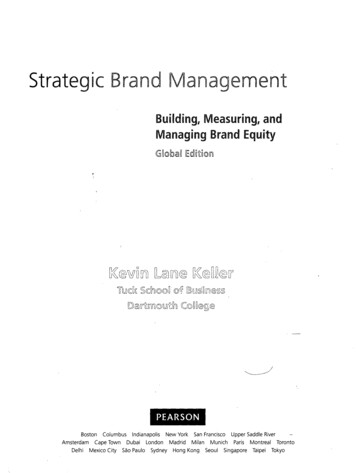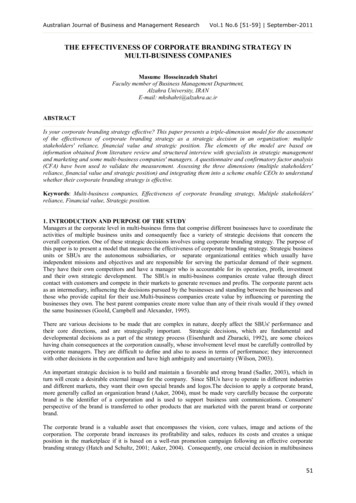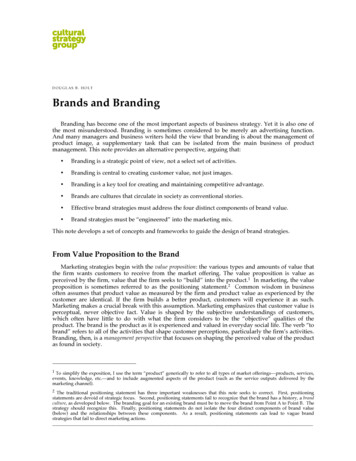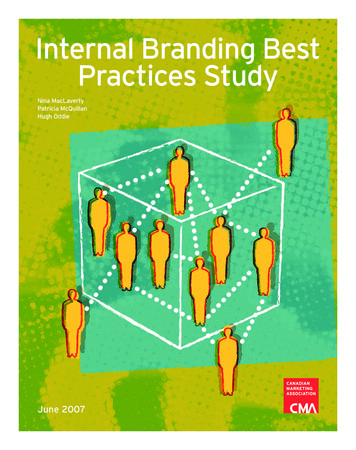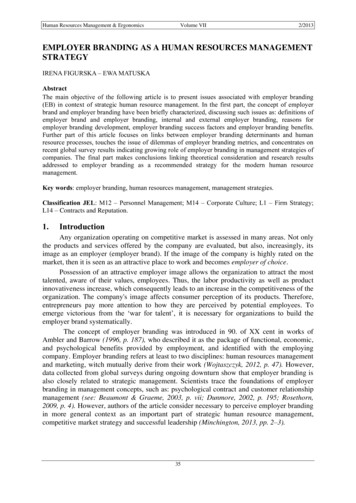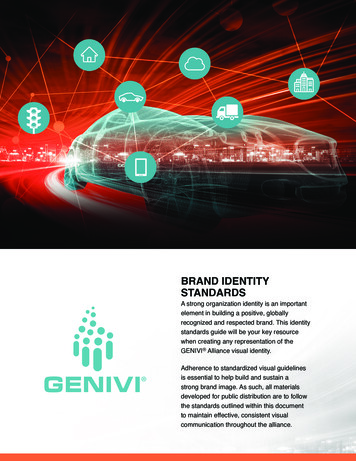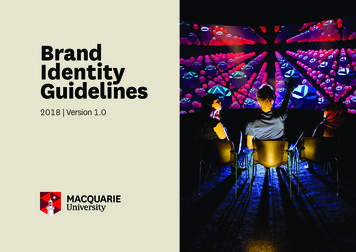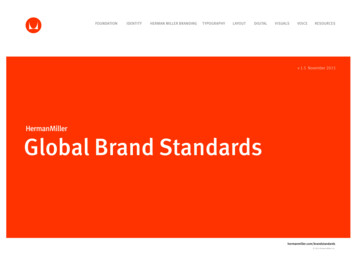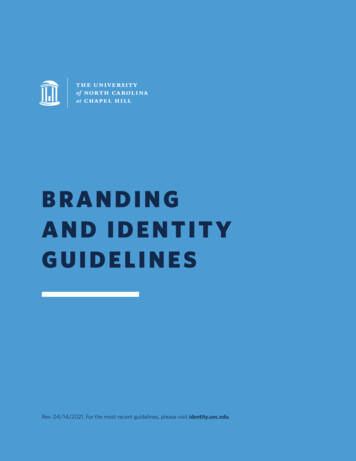
Transcription
BRANDINGAND IDENTITYGUIDELINESRev. 04/14/2021. For the most recent guidelines, please visit identity.unc.edu.
The nation’sfirst publicuniversity is atthe heart ofwhat’s next,as we prepare a diverse student body to become creators, explorers, innovatorsand leaders in North Carolina and throughout the world.The legacy that began in 1795, when the University first opened its doors tostudents, continues today with Carolina’s nationally recognized, innovativeteaching; campuswide spirit of inquiry; and dedication to public service.
Letter fromJoel Curran:With today’s crowded landscape, an organization’s brand is critical—it drivesawareness and recognition and evokes feelings. The University of NorthCarolina at Chapel Hill is the first public university in the nation. It has a richhistory of excellence as the “University of the People” and a dynamic presentand future as a major research institution. Because of its legacy and promise,UNC-Chapel Hill is a well-known, globally respected brand.As communicators, we are the stewards of that brand. The way that we present Carolina through visual, digitaland written communications helps strengthen our connection with all audiences and promotes our values andvision. Style guides are an important tool and a best practice used at peer universities and major organizationsto ensure that a consistent tone, look and feel are conveyed.The style guide for UNC-Chapel Hill includes standards for the use of the University logo, Carolina Blueand other identifying marks, as well as the expanded visual identity that supports the core brand. It alsoincorporates examples of good work and recommendations for visual design, photography, videography andwriting for the Carolina brand. This is a living document and will change as our brand evolves.It takes many people to maintain, promote and protect a brand, and everyone associated with the Universityhas a responsibility to uphold these guidelines. We must all work together to guarantee we present aconsistent Carolina brand image. I encourage and empower you to do this each day by using this guide.Best,Joel CurranJOEL CURRANVice Chancellor, University Communications
Table ofContentsBRANDCO N T E N T07 Brand Identity Elements39 Content Overview08 University Logo40 Photography12 Unit and Department Logos45 Videography18 Other University Marks48 Websites21 Color Palette51 Social Media24 Typography54 Writing Style26 Shapes and Patterns56 Editorial Style29 Textures31 Background Photo Treatment33 Photo Frames34 Callout Text Templates35 Brand ExamplesRESOURCES63 Resources Overview64 Stationery67 UNC Creative68 Strategic Resources69 Web Services70 Trademarks and Licensing71 Contact and Downloads
BRAND
Our brand reflectsthe Carolinaspirit and upholdsour longstandingreputation ofexcellence.It includes such elements as the Old Well and Carolina Blue, as well as howpeople think, feel and respond when the University of North Carolina at ChapelHill is referenced. We tell these brand stories through words and visuals,including powerful stories and engaging multimedia experiences. Together ascreators and storytellers—and as faculty, staff, students, alumni and communitymembers—we use these tools to strengthen the Carolina brand as we share ourstory with the world.
BRANDBrand Identity ElementsThe elements below are used to create the core and expanded visual identity ofthe University of North Carolina at Chapel Hill. Reference each section below tolearn more about proper usage and application in order to ensure the brand isapplied consistently across all University materials.1U N I V E R S I T Y LO G OHow to use the official Old Well logo for the University2U N I T A N D D E PA R T M E N T LO G O SHow to qualify for and properly use unit logos and department logos5OT H E R M A R K SWhen and how to use other University marks, including the seal, Tar Heel and interlocking NC3CO LO R PA L E T T EColor breakdowns and how to use the primary and secondary color palettes4TYPOGRAPHYHow to acquire and use the official University typefaces and acceptable substitutes5ADDITIONAL BRAND ELEMENTSHow to use additional brand elements, such as shapes, patterns, textures, a background phototreatment, photo frames and callout text templates6BRAND EXAMPLESSample projects that highlight brand elements and correct usage7BRANDING AND IDENTITY GUIDELINESBrand Identity Elements
BRANDUniversity LogoThe University of North Carolina at Chapel Hill logo is the keystone of our visualidentity. This logo, or a University unit or department logo, should be used onall communications materials. Using the logo consistently will enhance therecognition of the University by all audiences. The primary logo uses a horizontallayout and the secondary logo is centered in a vertical format.The primary logo should be the first choice when the University logo is used. When appropriate, it may besubstituted with the secondary logo.P R I M A RY LO G OS E CO N DA RY LO G OU S AG E The logo must be reproduced from high-resolution digital artwork. As the primary graphic identity for the University, the logo (or official unit logo or department logo) mustappear on all communications, including brochures, stationery, business cards and websites. The logo may not be reconstructed or altered in any way. This prohibition includes, but is not restricted to, type,the vertical line, outlines and embellishments. Do not create secondary logos, as this is confusing to audiencesand dilutes our goal of creating a common, mutually reinforcing image. The logo may not be cut or cropped in any way.8BRANDING AND IDENTITY GUIDELINESUniversity Logo
BRANDUniversity LogoI M P R O P E R LO G O T R E AT M E N T Do not configure the elements into a different logo. Do not crop or remove any part of the logo. Do not distort the logo. Do not tilt the logo in any direction. Do not add any shadows, effects or other elements to the logo. Do not alter the proportions of the logo. Do not attach a program-level identification to the logo or attempt to create your own unit or department logo. Do not duplicate any part of the logo to create a pattern. Do not recreate the type or substitute another typeface. Do not surround logo with other competing shapes.CO LO R O P T I O N SThe University logo comes in three different colors: Carolina Blue, black and white.9BRANDING AND IDENTITY GUIDELINESUniversity Logo
BRANDUniversity LogoSIZE REQUIREMENTSThe logo must be resized proportionally and in its entirety; therefore, measurements for all elements in the logoare relative to each other.Primary LogoWhen PMS 542 or black is used in printing the logo, the minimum width for the logo is 1.875 inches. When thelogo appears as a white knockout on a color background, the minimum width is 2 inches. If a 4-color processbuild is used to print the logo, the minimum width is 2 inches.1.875”2”Secondary LogoWhen PMS 542 or black is used in printing the logo, the minimum width for the logo is 1.215 inches. When thelogo appears as a white knockout on a color background, the minimum width is 1.3 inches. If a 4-color processbuild is used to print the logo, the minimum width is 1.3 inches.1.215”10BRANDING AND IDENTITY GUIDELINES1.3”University Logo
BRANDUniversity LogoC L E A R S PAC E R E Q U I R E M E N T STo ensure the integrity and visual impact of the logo, the appropriate “clear space” must be maintained on all sides.Specifically, where “x” is equal to the height of the Old Well icon, there must be a minimum of 1/2 the distance “x”between the outside edge of the logo and any other page element, including the edge of the page. The vertical linedividing “UNC” and the unit or department name may fall inside the clear space.xx½x½x½x½xLO G O M A R KThe Old Well, as pictured here, is the only acceptable logo mark. It may not be reconstructed or altered in any way.This logo mark may be used as a design element separate from the formal logo only if the formal logo appearselsewhere on the printed or digital piece. See examples below for clarification.Old Well icon onfront of postcard NEW UNC STUDENTStores PHARMACYEmployee Walk-InFlu Shot ClinicWork Well,Live Well ChallengeOffering convenient andprofessional pharmacy servicesto faculty, staff and students righton main campus. Stop by thetable at the fair to learn more.Student Union Room 25189 a.m. to 4 p.m.No Appointment NecessaryPick up your challenge card atthe WWLW table located in theDepartment Fair.ackland museum StoreAll UNC Chapel HillFaculty / StaffApprecation DayUNC Student StoresUNC Employee computer PlanYour computer purchase isPayroll Deductible!Visit the Tech Shop formore information.25% Employee Discountat Student Stores25% OFF UNC clothing andgifts, Bull’s Head books, schoolsupplies, and medical apparel(In-store purchases only; coursematerials are excluded).Store Hours 7:30 a.m.to 5:30 p.m.UNC Department Fair15% Discount on museummemberships and regularlypriced merchandise. This offeris good on Friday, October 16and Saturday, October 17, 2015.UNC employees, present yourOneCard.carolina cares,carolina sharesIt’s time again to show all stateagencies & universities thatTar Heels Give More!Oct. 1 – Dec. 10. Find yourpassion with over 1,000 charities.Payroll Deduction available.For more information visit:carolinacares.unc.edu 10 football tickets – Oct. 17vs. Wake ForestTo purchase tickets, please call962-2296 & provide promocode: FB15 – FACULTYor visit GOHEELS.COM/Tickets– click Promotions – Enter Code.This is a work-time event, with advanceapproval from your supervisor. Rainlocations: Underground Lounge,Student Union.We would like to thank the followingsponsors for their support: FPGStudent Union, UNC Student Stores,Carolina Dining and Pepsi.Great Hall, Student Union9 a.m. until 3 p.m.Event hosted by theUniversity Office of Human Resources Full University logoon back of postcard11BRANDING AND IDENTITY GUIDELINESUniversity LogoAlyssa StepienUNC CreativeCB #6200200 N. Greensboro St., Suite D3Carrboro, NC 27599-6200
BRANDUnit and Department LogosThe University identity system has two levels of logos under the main Universitylogo: unit and department.U N I T LO G O SUnit logos are a way of branding individual units within the University. University units include approved schools,centers, institutes, foundations, vice chancellor units, vice provost units and direct reports to the chancellor orprovost. Any group meeting one of these criteria is eligible to receive a unit logo, which must be created by UNCCreative. Unit logos can replace the main University of North Carolina at Chapel Hill logo on printed and onlinematerials; it is not necessary to use both logos.D E PA R T M E N T LO G O SDepartment logos are a way of branding individual groups within a University unit. Any group within a unit, such asa department, office, division or program, is eligible to receive a department logo. The decision on how to allocatedepartment logos is made at the unit level and requires approval by the respective dean, vice chancellor or viceprovost. All department logos must be created by UNC Creative. Department logos can replace the main Universityof North Carolina at Chapel Hill logo on printed and online materials; it is not necessary to use both logos.12BRANDING AND IDENTITY GUIDELINESUnit and Department Logos
BRANDUnit and Department LogosU S AG EAll groups allocated a unit logo or department logo have access to horizontal and vertical versions of their respectivelogo. This provides flexibility of use in print and online materials. All logos adhere to a specific naming conventionthat eliminates extraneous words in a consistent manner across the University. For example, the text in the logo for“Office of University Communications” becomes “University Communications.”In order to ensure consistency across the University, all words must be spelled out completely and must not beabbreviated. Non-alphanumeric characters, such as ampersands (&) and at symbols (@), may not be used.When using a unit or department logo, the University’s full name, “The University of North Carolina at Chapel Hill,”must appear elsewhere on the publication. Unit and department logos can replace the main University of NorthCarolina at Chapel Hill logo on printed and online materials; it is not necessary to use both logos.C L E A R S PAC E R E Q U I R E M E N T STo ensure the integrity and visual impact of the logo, the appropriate “clear space” must be maintained on all sides.Specifically where “x” is equal to the height of the Old Well icon, there must be a minimum of 1/2 the distance “x”between the outside edge of the logo and any other page element, including the edge of the page. The vertical linedividing “UNC” and the unit or department name may fall inside the clear space.These clear space requirements apply to all unit and department logos.x½x½x13BRANDING AND IDENTITY GUIDELINESUnit and Department Logos
BRANDUnit and Department LogosSIZE REQUIREMENTSThe logo must be resized proportionally and in its entirety; therefore, measurements for all elements in the logo arerelative to each other.When PMS 542 or black is used in printing of the logo, the minimum height of the Old Well in the logo is 0.25 inches.When the logo appears as a white knockout on a color, the minimum height of the Old Well in the logo is 0.3125 inches.If a 4-color process build is used to print the logo, the minimum height of the Old Well in the logo is 0.3125 inches.These size requirements apply to all unit and department logos.0.25”0.3125”CO LO R O P T I O N SUnit and department logos come in four different colors: Carolina Blue and black, Carolina Blue, black and white.14BRANDING AND IDENTITY GUIDELINESUnit and Department Logos
BRANDUnit and Department LogosCO LO R A N D LO G O R E S T R I C T I O N S Do not change any colors of the logo. Do not screen any of the logo colors. Do not print the logo in black over a dark background. Do not print the reversed (white) logo onto a light or white background. Do not place the logo over a heavily patterned background.U S AG EAll groups allocated a unit logo or department logo have access to horizontal and vertical versions of their respectivelogo. This provides flexibility of use in print and online materials. All logos adhere to a specific naming conventionthat eliminates extraneous words in a consistent manner across the University. For example, the text in the logo for“Office of University Communications” becomes “University Communications.”In order to ensure consistency across the University, all words must be spelled out completely and must not beabbreviated. Non-alphanumeric characters, such as ampersands (&) and at symbols (@), may not be used.When using a unit or department logo, the University’s full name, “The University of North Carolina at Chapel Hill,”must appear elsewhere on the publication. Unit and department logos can replace the main University of NorthCarolina at Chapel Hill logo on printed and online materials; it is not necessary to use both logos.15BRANDING AND IDENTITY GUIDELINESUnit and Department Logos
BRANDUnit and Department LogosSUB-BRANDSA sub-brand is more than a logo. It is a complete identity system for an individual unit or department that fitswithin the main University brand, but has its own key design elements for a consistent and unique visual style. Anyapproved University unit or department may create a sub-brand. Effective sub-brands often include elements suchas color, patterns, typography and overall aesthetic. Creating a sub-brand is a way to customize communications andmarketing efforts for both internal and external audiences, while also leaning on the parent UNC-Chapel Hill brand forexternal recognition.Creating a brand guide that defines the elements within a sub-brand and provides usage guidelines is the best way toimplement and maintain an identity system. Sub-brands can contain some or all of the following elements:Color PaletteWhile Carolina Blue should be the main color of any department brand, choosing a secondary color palette canconvey a mood and style that is specific to the area that is being represented. In this example, vibrant colors werechosen to evoke a friendly and approachable feeling.PatternsGroups on campus do not always have access to custom photographs or illustrations. Creating a custom patternis a way to add visual interest to a design, and it can be used in a variety of ways. In this example, patterns werecreated from various geometric shapes to mimic the architecture on campus.16BRANDING AND IDENTITY GUIDELINESUnit and Department Logos
BRANDUnit and Department LogosTypographyAlthough using University fonts is encouraged, it is not required. The fonts selected will greatly affect the overallfeel of marketing and communications pieces. In this example, sans serif fonts were chosen for headline and bodycopy to again achieve that friendly feel. A more stylized serif font was chosen as an accent for instances that needa bit of extra flair.Sub-brand Typeface ExampleSub-brand Typeface Exampleabcdefghijklmnopqrstuv UV W X her ElementsA sub-brand can be created out of a variety of elements, although those listed above are the most common.Other examples are photography styles, custom illustrations and icon sets.Branded Design ExamplesA sub-brand can, and should, apply to all of thematerials created by a particular unit. Folders,newsletters, greeting cards, fact sheets, flyersand social media graphics can incorporate thebranding elements and create consistencyacross marketing and communications pieces. Asub-brand saves time in the long run becauseit provides a common starting point every timea new piece is designed. On the right are someexamples of items created for a sub-brandutilizing elements established in a brand guide.UNC CreativeUNC CreativeCREATIVE.UNC.EDUCREATIVE.UNC.EDUTHE UNIVERSITY OF NORTH CAROLINA AT CHAPEL HILL17BRANDING AND IDENTITY GUIDELINESUnit and Department Logos
BRANDOther University MarksThere are a number of logo marks associated with the University in addition tothe official University logo and the unit and department logos. Each of thesemarks has specific usage criteria and guidelines. In general, they should not beconsidered for primary use.You can download a full list of University registered and trademarked logos from the Office of Trademarks andLicensing’s website, licensing.unc.edu.UNIVERSITY SEALThe University seal should not be substituted forthe University of North Carolina at Chapel Hill logo.There are three authorized versions of the seal, andUniversity departments, as described below, may useonly one of these: the Latin University seal.The two English versions of the University seal may be used only on licensed merchandise as described by theOffice of Trademarks and Licensing.Usage:Corporate seal: The embossed version of the seal, either in a document itself or in gold foil that is affixed to adocument, must be authorized by the Office of the Chancellor.Diplomas and graduation materials: The multi-color version of the University seal may be used on diplomasapproved by the University Registrar and on graduation announcements available through Student Stores. UNCCreative may also authorize use of the University seal on other materials related to the granting of degrees.Transcripts: Official transcripts for work performed at the University are embossed with the University seal,under the authority of the University Registrar.University accomplishments: The University seal may be used on documents and in other media that indicateaccomplishment in or on behalf of the University. In such cases, the seal must be printed in black ink or in thecolor in which the rest of the document is printed.University Libraries bookplates: The University seal may be used as a mark of ownership on selected Universityowned books.18BRANDING AND IDENTITY GUIDELINESOther University Marks
BRANDOther University MarksAT H L E T I C S LO G O SThe three primary athletics logos are the Tar Heel foot, the interlocking NC and the ram. Universityschools, centers, institutes, departments and administrative units should utilize the University’sOld Well logo or their respective unit or department logo as the primary mark in any marketing orcommunications piece. To use athletics trademarks on media such as mugs or t-shirts, consult the Officeof Trademarks and Licensing for clearance before proceeding. This office can also provide informationand instructions regarding the purchase of such materials for internal use or resale.U N C H E A LT H A N D U N C M E D I C A L C E N T E R LO G O SUNC Health is an academic health system proudly affiliated with UNC School of Medicine and the Universityof North Carolina at Chapel Hill. UNC Medical Center, also known as UNC Hospitals is the 950 bed hospitallocated in Chapel Hill, NC. UNC Health maintains its brand assets, including the master brand, all owned andaffiliate hospital logos and other various logos and marks throughout the health care landscape. Detailedguidelines can be accessed at brand.unchealth.org.19BRANDING AND IDENTITY GUIDELINESOther University Marks
BRANDOther University MarksC U S TO M LO G O SThe following groups and initiatives are outside the University logo system and do not have a standardized unitlogo or department logo: events, studies, campus-wide initiatives, revenue generators, groups funded outside ofthe University, alumni groups and student groups. These groups and initiatives may create their own unique logo,which can be paired with the main University logo, or a unit or department logo, when appropriate. Custom logoscannot use elements from other trademarked logos.O F F I C I A L M A R K S VS . A R T I S T I C R E P R E S E N TAT I O NA custom logo or design that includes an element from a trademarked icon (e.g., the Old Well icon) must use anartistic representation instead of the official icon. Artistic representations must be distinctly different from theUniversity icons. The design of artistic representations should not start by using or closely mirroring the officialUniversity marks. To learn more about when an artistic representation is required or to request design approval,contact UNC Creative at creative.unc.edu/work-with-us.20BRANDING AND IDENTITY GUIDELINESOther University Marks
BRANDColor PaletteThe University brand uses both a primary and secondary color palette. Theprimary color palette should be used predominantly on materials, while thesecondary color palette should be used sparingly as accents to complementthe primary palette. Carolina Blue is the main color of the University and mustbe used at least 10% on all designs.Adhering to the following color reproduction guidelines will help to create a consistent image and maintain thevisual impact of the identity.P R I M A RY PA L E T T ES E CO N DA RY PA L E T T E21BRANDING AND IDENTITY GUIDELINESColor Palette
BRANDColor PaletteCO LO R B R E A K D OW N SCarolina BluePMS 542CMYK 60, 19, 1, 4Hex #4B9CD3RGB 75, 156, 211NavyPMS 2767CMYK 100, 90, 10, 77Hex #13294BRGB 19, 41, 75BlackPMS Black 3CMYK 74, 52, 71, 90Hex #151515RGB 21, 21, 21White(none)CMYK 0, 0, 0, 0HEX #FFFFFFRGB 255, 255, 255Basin SlatePMS 5405CMYK 68, 35, 17, 40HEX #4F758BRGB 79, 117, 139Campus SandstonePMS 2309 at 50%CMYK 3, 8, 11, 0HEX # F4E8DDRGB 244, 232, 221Longleaf PinePMS 561CMYK 84, 20, 58, 54HEX #00594CRGB 0, 89, 76Tile TealPMS 7466CMYK 97, 0, 30, 0HEX #00A5ADRGB 0, 165, 173Sunburst YellowPMS 109CMYK 0 10, 100, 0HEX #FFD100RGB 255, 209, 0Davie GreenPMS 382CMYK 28, 0, 100, 0HEX #C4D600RGB 196, 214, 0Digital Links #007FAEDome CopperPMS 8920 metallicInfinity foil 62Use Pantone color orInfinity foil only. Notintended for digital use.Azalea PinkPMS 191CMYK 0, 79, 36, 0HEX #EF426FRGB 239, 68, 11122BRANDING AND IDENTITY GUIDELINESColor PaletteGrayPMS Black 3 at 6%CMYK 4, 3, 3, 0HEX #F8F8F8RGB 248, 248, 248
BRANDColor PaletteG U I D E L I N E S F O R U S AG EDo: Use at least 10% Carolina Blue on all designs. Make sure to use proper color breakdowns forspecific uses. Use colors from the primary color palette as themain colors in a design. Use colors from the secondary color palette foraccents only. Make sure text and background color contrast meetWCAG 2.1 AA guidelines for web and digital designs.Don’t: Omit Carolina Blue on any design. Eyeball or guess at a specific color. Use colors from the secondary color palette asprimary colors.W E B CO LO R U S AG EThe University adheres to the Web Content Accessibility Guidelines (WCAG) 2.1, Level AA for all websites. Forinformation on usage of color on websites, please refer to the guidelines and resources on the Websites sectionof identity.unc.edu.23BRANDING AND IDENTITY GUIDELINESColor Palette
BRANDTypographyThe official University typefaces are Bembo Std, Whitney and ITC FranklinGothic LT Pro.Bembo Std and Whitney are licensed and must be purchased. In the event that a unit does not have access to thesefonts or does not want to invest in a license, there are recommended substitute typefaces listed on the next pagethat can be installed at no cost.ITC Franklin Gothic LT Pro is available to use for free with an Adobe Creative Cloud license.The University typefaces are suggested for use on University print projects and the substitute typefaces aresuggested for digital and web projects.O F F I C I A L U N I V E R S I T Y T Y P E FAC E SBembo vwxyz1234567890Bembo Std RegularBembo Std ItalicBembo Std SemiboldBembo Std Semibold ItalicBembo Std BoldBembo Std Bold ItalicBembo Std ExtraboldBembo Std Extrabold lmnopqrstuvwxyz1234567890Whitney LightWhitney Light ItalicWhitney BookWhitney Book ItalicWhitney BoldWhitney Bold ItalicWhitney BlackWhitney Black Italic24BRANDING AND IDENTITY GUIDELINESWhitney MediumWhitney Medium ItalicTypographyWhitney SemiboldWhitney Semibold Italic
BRANDTypographyITC Franklin Gothic LT ProITC Franklin Gothic LT Pro Demi Compressed and Demi Compressed Italic are the only fonts from this family thatmay be used. These fonts should always be used in all caps when used in conjunction with the University brand.ABCDEFGHIJKLMNOPQRSTUVWXYZ1234567890ITC FRANKLIN GOTHIC LT PRO DEMI COMPRESSED (all caps)ITC FRANKLIN GOTHIC LT PRO DEMI COMPRESSED ITALIC (all caps)L I N K S TO P U R C H A S E :Bembo Std (MyFonts: myfonts.com/fonts/adobe/bembo)Whitney (Hoefler & Co.: typography.com/fonts/whitney)ITC Franklin Gothic LT Pro (Adobe Fonts: fonts.adobe.com/fonts/itc-franklin-gothic)R E CO M M E N D E D T Y P E FAC E S U B S T I T U T E SAlthough Bembo Std is available as a web font, Libre Baskerville is preferable because of its on-screen clarity andreadability. Whitney is also available as a web font and is recommended for online use. An acceptable substitutefor Whitney is Open Sans. ITC Franklin Gothic LT Pro is an approved web font and there is no substitute.Libre Baskerville (Google Fonts: fonts.google.com/specimen/Libre Baskerville)Open Sans (Google Fonts: fonts.google.com/specimen/Open Sans)M O R E I N F O R M AT I O NFor more information and to view the University’s Branding and Identity Guidelines, visit identity.unc.edu.25BRANDING AND IDENTITY GUIDELINESTypography
BRANDShapes and PatternsShapes and patterns may be used to create continuity throughout your materialsand increase brand recognition. Drawing inspiration from the Old Well andAthletics’ argyle, a number of shapes and patterns have been designed and addedto the University identity system as optional elements.SHAPESDome ShapesDiamond ShapesDiamond Lockups26BRANDING AND IDENTITY GUIDELINESShapes and Patterns
BRANDShapes and PatternsPAT T E R N SDome PatternsDiamond PatternsCombination Pattern27BRANDING AND IDENTITY GUIDELINESShapes and Patterns
BRANDShapes and PatternsG U I D E L I N E S F O R U S AG EDo: Use .eps files for print and .png files for web. Alter the colors of the shapes and patterns to anybrand color when necessary. Alter the transparency of the shapes and patterns touse them in a subtle way. Crop or zoom into the shapes and patternsproportionally when necessary. Consider accessibility when using as a layer on the web.28BRANDING AND IDENTITY GUIDELINESDon’t: Edit the layout of the patterns. Use the shapes to create custom logos. Overlay the shapes and patterns on top of a clashingbackground. Use patterns behind body copy.Shapes and Patterns
BRANDTexturesTextures, inspired by low stone walls, the Davie Poplar and water from the OldWell fountain, may be used to create continuity throughout your materials andincrease brand recognition.TEXTURESStoneTreeWater29BRANDING AND IDENTITY GUIDELINESTextures
BRANDTexturesG U I D E L I N E S F O R U S AG EDo: Use .eps files for print and .png files for web. Alter the colors of the textures to any brand colorwhen necessary. Alter the transparency of the textures to use them ina subtle way. Crop or zoom into the textures proportionally whennecessary. Consider accessibility when using as a layer on the web.30BRANDING AND IDENTITY GUIDELINESTexturesDon’t: Edit the layout of the textures. Use the textures to create custom logos. Overlay the textures on top of a clashingbackground. Use as the predominant visual element on a page.
BRANDBackground PhotoTreatmentCreating duotone images of your photographs and using them as backgroundscan add visual interest to your materials.In order to maintain consistency with the Carolina brand, it is important to use only the files provided in the Downloadssection of identity.unc.edu to create these duotone images and to follow the guidelines below.T R E AT M E N T CO LO R O P T I O N SS T E P S F O R C R E AT I N G A B AC
Brand Identity Elements. BRAND 8 BRANDING AND IDENTITY GUIDELINES University Logo The University of North Carolina at Chapel Hill logo is the keystone of our visual identity. This logo, or a University unit or department logo, should be used on all communication
